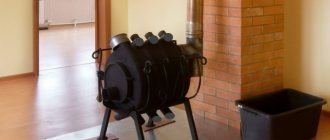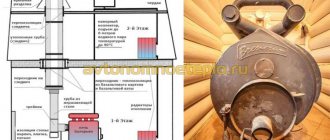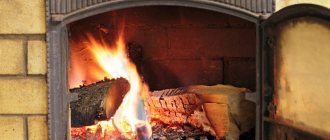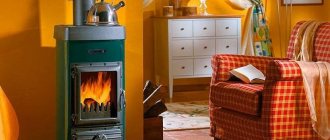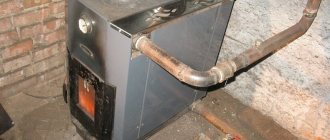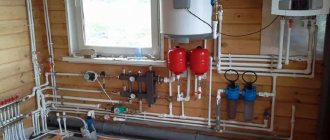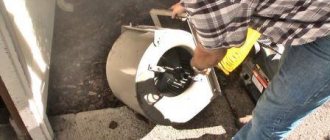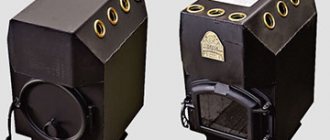Unlike natural gas, diesel fuel or electricity, firewood is a publicly available resource. In regions with significant forest resources, the cost at which firewood can be purchased is sometimes determined only by the difficulty of delivering it to the consumer, and the price of a kilowatt of thermal energy obtained in the process of burning firewood is significantly less than the cost of the same kilowatt obtained from burning gas, fuel oil, diesel fuel, or using electric heating. And this state of affairs is typical for almost the entire territory of our country.
Under these conditions, the use of wood-burning boilers for heating becomes not only possible, but also beneficial in terms of cost reduction. One of the types of wood-burning boilers are long-burning boilers with a water circuit. The use of such boilers allows you to distribute heat throughout the house as efficiently as possible using a water heating system.
The design and principle of operation of a wood-burning boiler
Firewood belongs to the group of solid fuels and can be used on the same level as coal for heating residential buildings no higher than 2 floors, and is also well suited for organizing air heating in the house.
Installation of a wood-fired boiler. Photo source: rgagroup.ru
Wood-burning hot water boilers are conventionally divided into 2 types:
- non-volatile, operating with the natural draft of the chimney;
- supercharged, in which air is forced into the firebox.
The first ones use simple oven technology, with the only difference being that they have an internal water circuit. A large combustion chamber is located above the ash pit, separated from it by grates.
Air from the room is supplied to the combustion device through a damper in the ash pan, and then moves through the grate. The supply volume is adjusted by a thermostat that controls the temperature of the coolant in the water jacket of the boiler unit. The damper control is mechanical.
The exhaust gases formed in the combustion space at a high temperature move through the flame tubes of the internal heat exchanger and are cooled through the walls of the tubes by heating water.
Based on the structural elements of the boiler unit, flue gases are able to circulate several times through the flue pipes, effectively exchanging thermal energy with the water jacket.
Operating principle. Photo source: stroikabudet.ru
Giving up their heat, volatile substances formed from fuel combustion leave the heating boiler with flue gases using a flue exhaust system.
A non-volatile wood-burning boiler cannot boast of good efficiency, at most it is 70%.
The second version of the heat generator is the most productive; its efficiency can reach 75% due to forced air supply carried out by a supply fan.
Strapping scheme
A typical connection diagram for boilers for heating with wood contains two basic units that allow it to operate reliably in heating systems of an individual home. This is a safety group and a water group with a three-way valve with a thermal head and a temperature sensor.
Unfortunately, due to its design features, this heating source cannot use modern automation and control systems. The boiler's piping along the water circuit of the heating network and the exhaust of flue gases is carried out according to the counterflow principle, that is, the media move towards each other.
Connection diagram with boiler
This design of wood-burning boilers for heating allows you to reduce the temperature of the flue gases. But, as evidenced by the real efficiency of wood-burning boilers, this does not happen very well.
To increase the efficiency of the entire thermal circuit, it is recommended to include an indirect hot water boiler with a water tank. It allows you to reduce the temperature of exhaust gases and additionally heat hot water, at the same specific fuel consumption.
Design
Solid fuel boilers have a simple operating principle. The combustion chamber is placed in a steel casing; fuel is loaded through the door on the front side of the boiler and ignited.
During fuel combustion, hot flue gases wash a heat exchanger, made in the form of pipes or a water jacket, and transfer heat to the water of the heating circuit. When heated, the water begins to move naturally along the circuit due to the temperature difference at the inlet and outlet of the boiler.
Cooled boiler gases are carried away into the atmosphere through the chimney, also due to the temperature difference at the inlet and outlet of the boiler. Under the firebox there is an ash pan, which is designed to collect unburned parts of the fuel.
The ash chamber door acts as a damper to regulate the air supply to the combustion zone to ensure complete combustion.
Advantages and disadvantages
This type of heating has a significant list of advantages, in the first place of which is the economy of the heating option, which is caused not only by the lowest prices for wood fuel, but also by the low costs of installing and operating heating equipment.
The main advantages of boilers for heating with wood:
- Environmental Safety. Due to low emissions of harmful substances into the atmosphere.
- The technological simplicity of the boiler using wood and coal guarantees a long period of operation.
- The variability of the stove device, the possibility of using all types of solid fuel, for any premises, for example, for a wood-burning bathhouse.
- Energy independence.
- Possibility of heating large areas of 1000-1500 m2.
- Wide selection of types of units with a water circuit.
- The ability to create a water heating circuit with your own hands.
Disadvantages of solid fuel boilers:
- Need for additional fuel storage space.
- Low comfort levels and the need for constant care.
- High download frequency.
- Low level of automation and regulation.
Installation features
To heat a small home, it is advisable to install it directly in the house itself. Also, the boiler room can be equipped as a separate building or inside other outbuildings.
Construction of a solid fuel boiler
In this case, the heating pipe is always laid underground, always below the freezing level of the soil, and thermal insulation is ensured. In the boiler room, the air temperature should be at 10 degrees, and special care should be taken to ensure high-quality ventilation equipment.
Advice. You can equip an insulated mini-boiler room in the basement or on the first floor of the house, and also allocate space there for a fuel supply.
The floor covering at the installation site must be non-flammable, level and hard. To increase the strength of the floor, the boiler is installed on a thin concrete screed. A sheet of metal with an area of at least 1 square meter must be placed in front of the heating unit. m.
Attention! The distance from the heating equipment to the walls of the room must be at least 50 cm.
During installation, you should strictly adhere to all recommendations given in the operating instructions for boiler equipment regarding the main parameters of chimneys: cross-section and height. The joints between the chimney and the chimney must be filled with heat-resistant sealant or coated with a clay solution.
Installation of a solid fuel boiler
Types of wood boilers
A wood-burning boiler is a highly efficient heating equipment installed as a source of heat supply in autonomous systems in order to maintain sanitary and hygienic living conditions in houses of medium and small size.
These installations are equipped with special safety components to ensure safe operation. The units operate in the efficiency range from 70 to 80%.
There are quite a few modifications of boilers. Photo source: remoo.ru
Classification of solid fuel boilers:
- Classic direct combustion boilers. Despite the fact that they are significantly inferior to the latest devices in terms of operating time from 1 load, they are still popular due to their low price.
- Top combustion boilers are cylindrical in shape and equipped with a specialized telescopic air tube. Due to the fact that the combustion process also occurs at the top of the combustion chamber, a new portion of fuel can be added after the combustion of the previous layer.
- Bottom combustion boilers have a particularly well-thought-out and efficient design of mine boiler units with long-term combustion of the bottom layer. This makes it possible to fill the firebox with firewood at any time during operation.
- The pyrolysis device is a gas-generating wood-fired boiler with 2 combustion chambers. In the first, primary combustion takes place with a deficiency of oxygen, which triggers the process of pyrolysis and gas generation. The second is for complete combustion of synthesis gas. This design makes it possible to increase the operating time of the boiler with one filling of firewood.
- Pellet boilers are produced to operate on pressed or granulated wood waste and are equipped with a special hopper, from which fuel enters the combustion chamber using an auger.
Wood and electric boiler
Manufacturers of wood-burning boilers, to protect the interests of consumers, decided to modify them and eliminated the main drawback - a significant decrease in the temperature of the coolant in the system between firing sessions.
Electric heating was integrated into the system of electric wood-burning boilers, thus creating boilers with combined heating.
Such heat sources combine all the advantages of electric and wood heating in one device, in which consumers are very interested.
Units powered by wood and electricity also work well in tandem with an indirect heating boiler and can heat water at night according to the tariff metering, thereby making such a heating system extremely economical.
Popular models
The following models of wood heating equipment are in demand among consumers:
- Buderus. Logano G 211–26 D products can be loaded with various solid fuels - wood, coal, coke, pellets. There are devices with a power of 15 and 32 kilowatts.
- Zota Pellet. Models of this series are used not only for heating the house, but also for hot water supply. They have a protection system, efficiency exceeds 85%. The boilers are equipped with electric ignition and an automatic function for maintaining the required temperature regime. Their power reaches 100 kilowatts. Weight is 300-800 kilograms.
Geyser. One stack of wood is enough for 7–18 hours of work. These boilers are equipped with automatic draft control.
The most reliable and economical wood boilers
Firewood burns out pretty quickly. To prolong this process as long as possible, they achieve the process of smoldering fuel. For this purpose, special combustion structures have been made that allow working on one load for 4 hours or more.
The result was very inexpensive, popular boiler designs: Evan WARMOS-TK-12.0 and Lemax Forward-12.5.
Main characteristics of Evan WARMOS-TK-12.0:
- Brand country: Russia.
- Production - Russia.
- Heating capacity using wood is 9 kW.
- Boiler type: non-volatile.
- Number of circuits: single-circuit, heating.
- The firebox is open.
- Automation - by air.
- The metal of the heat exchanger is steel.
- Firewood burning time is 5 hours.
- Chimney – 114 mm.
- Dimensions – 620x440x930 mm.
- Weight – 250 kg.
- Warranty – 1 year.
- Price – 20,500 rub.
Main characteristics of Lemax Forward-12.5:
- Brand country: Russia.
- Production - Russia.
- Heating capacity using wood is 12 kW.
- Boiler type: non-volatile.
- Number of circuits: single-circuit, heating.
- The firebox is open.
- Automation - adjusting the level of air supply to the burner.
- The metal of the heat exchanger is steel.
- Firewood burning time is 4 hours.
- Chimney – 140 mm.
- Dimensions – 121x109x917 mm.
- Weight – 70 kg.
- Warranty – 3 years.
- Price – 16,500 rub.
Wood boiler maintenance
Much to our chagrin, most owners of wood-burning boilers for heating a private home pay little attention to the operating features of the device.
Such boilers require high-quality maintenance. Photo source: hearth.com
However, a wood-burning boiler has its own differences in operation, which require certain operations:
- Preparing the chimney. Before putting such a unit into operation, it is necessary to inspect the gas duct and, if necessary, clean it of soot, and in the future it is recommended to perform this operation at least once every two months.
- The main points in boiler maintenance are loading firewood and cleaning the combustion chamber. In order to create oxygen access to the torch, when loading firewood, they are not stacked tightly.
- Cleaning is carried out using special devices included with the boiler.
- It is not recommended to completely clean the grate; a small amount of ash on the grate can serve as thermal insulation and, thereby, increase the service life of the boiler.
Principles of calculation
In order not to make mistakes when calculating heating, you need to first draw a diagram on paper. All components of the structure are indicated on it
It is important to understand how much fluid flows through all the nodes separately, at what speed it moves, how the operation of the entire system changes as a result of changes in the functionality of its individual elements
During the calculation, you should not miss the hydrodynamic resistance of water as it moves, which affects the pressure inside the system and pressure. To carry out the procedure, special tables and formulas are used. Correct calculation will avoid problems with the functionality of the heating structure in the future.
Is it possible to do it yourself?
The device that uses wood fuel is very simple and it is quite possible to make a wood-burning boiler with your own hands for those who know how to handle basic plumbing tools and a welding machine.
A cauldron made by myself. Photo source: biser.enjob.ru
Step-by-step instructions for a homemade wood-burning boiler:
- A DIY wood-burning boiler is made from a 200 liter metal barrel. The lid is cut off and the side is welded. A piston with a diameter smaller than the container is made from a powerful blank or other weighting material. You can use components for pumping stations and cables.
- A hole is made in the cover to accommodate a 100 mm air duct. In height, it is arranged 20 cm above the level of the barrel.
- A 100 mm chimney outlet is installed on the side.
- The air duct is welded to the piston. A damper is installed on the top of it, regulating the volume of required air. Special ribs are welded to the bottom of the piston structure to compact the firewood.
Such homemade boiler units with a long-burning principle can operate for more than a day on one stack of firewood.
Manufacturing a mine unit - procedure
The first stage of work is the assembly of the KDG body from blanks 4 mm thick. First, the side walls, door openings and vault cover are welded to the bottom of the homemade structure. Corners are mounted inside the resulting firebox. Grate bars are installed on them. The finished structure is welded along all existing seams. It must be sealed.
The second stage is the installation of a water circuit (it is 2 cm away from the body), assembled from 3 mm blanks, and welding pieces of steel strips to the side walls. The latter are necessary for attaching sheathing sheets to them. Important! The jacket does not cover the ash chamber. It starts at the level of the grate.
The third step is the installation of flame pipes in the boiler tank (in the upper part). They are mounted in openings that need to be made in the front and rear walls. The ends of the pipe products are hermetically welded. Then grate bars are made from the corners in the form of a grate and a door. Two rows of steel strip are attached to the latter from the inside, between which a narthex seal is placed - an asbestos cord. The grate bars additionally serve as an air diffuser, directed into the ash pan by a fan.
Special devices - fittings - are cut into the walls of the tank. They make it possible to connect the return and supply pipelines. An air duct is installed (a flange is immediately mounted on it to secure the fan) and a smoke exhaust pipe. The air duct is introduced into the ash compartment from the rear (approximately in the middle).
Embedded elements for installing the KDG casing and door hinges are welded to the body. The homemade unit is finished with insulation on top and on all sides. It is secured with a cord. The metal sheets are screwed to the heat insulator with self-tapping screws and the doors are installed.
The final work is connecting the control module on top of the boiler, installing a fan on the flange of the air pipe, and a temperature sensor under the insulation on the rear wall. The continuous burning unit is ready for use.
